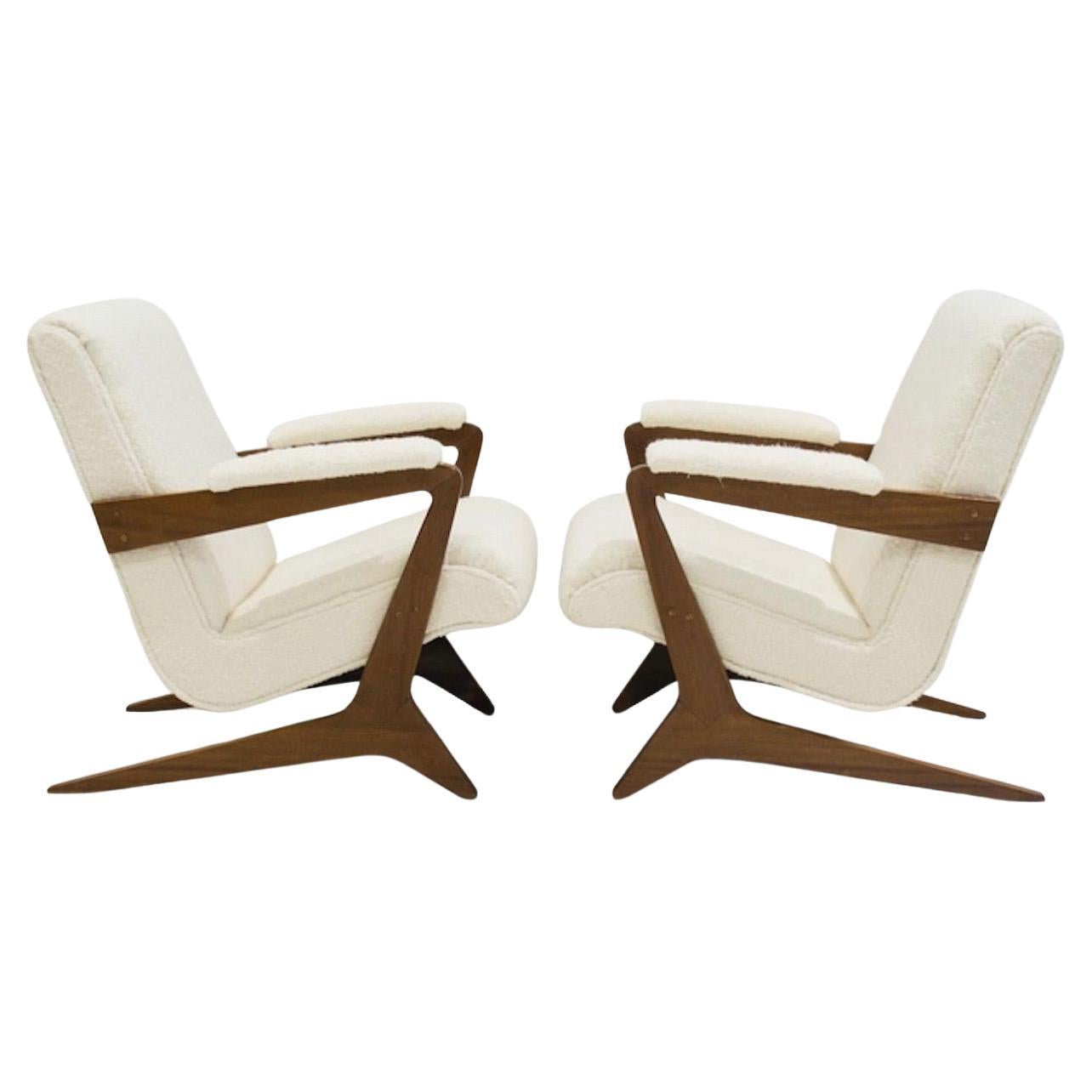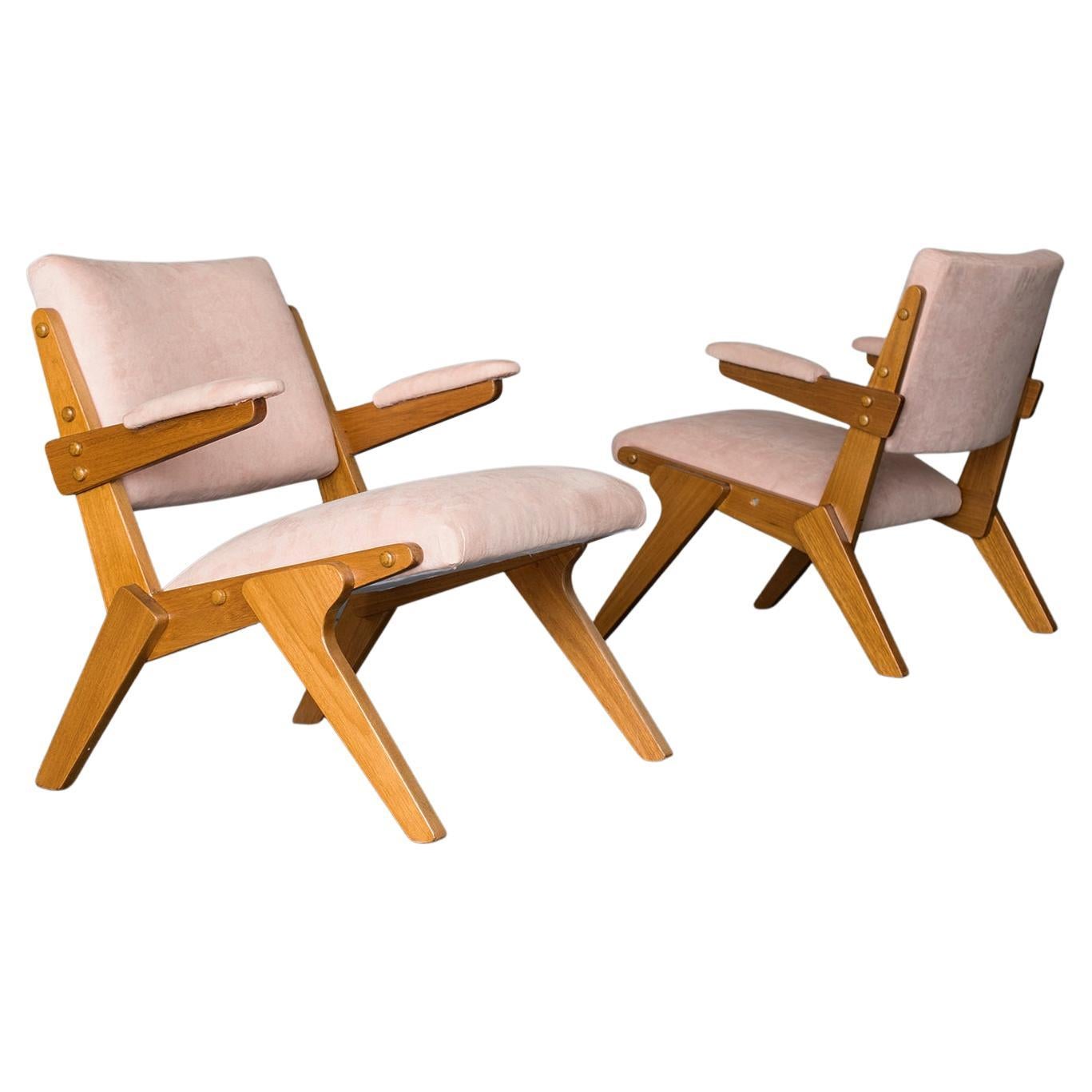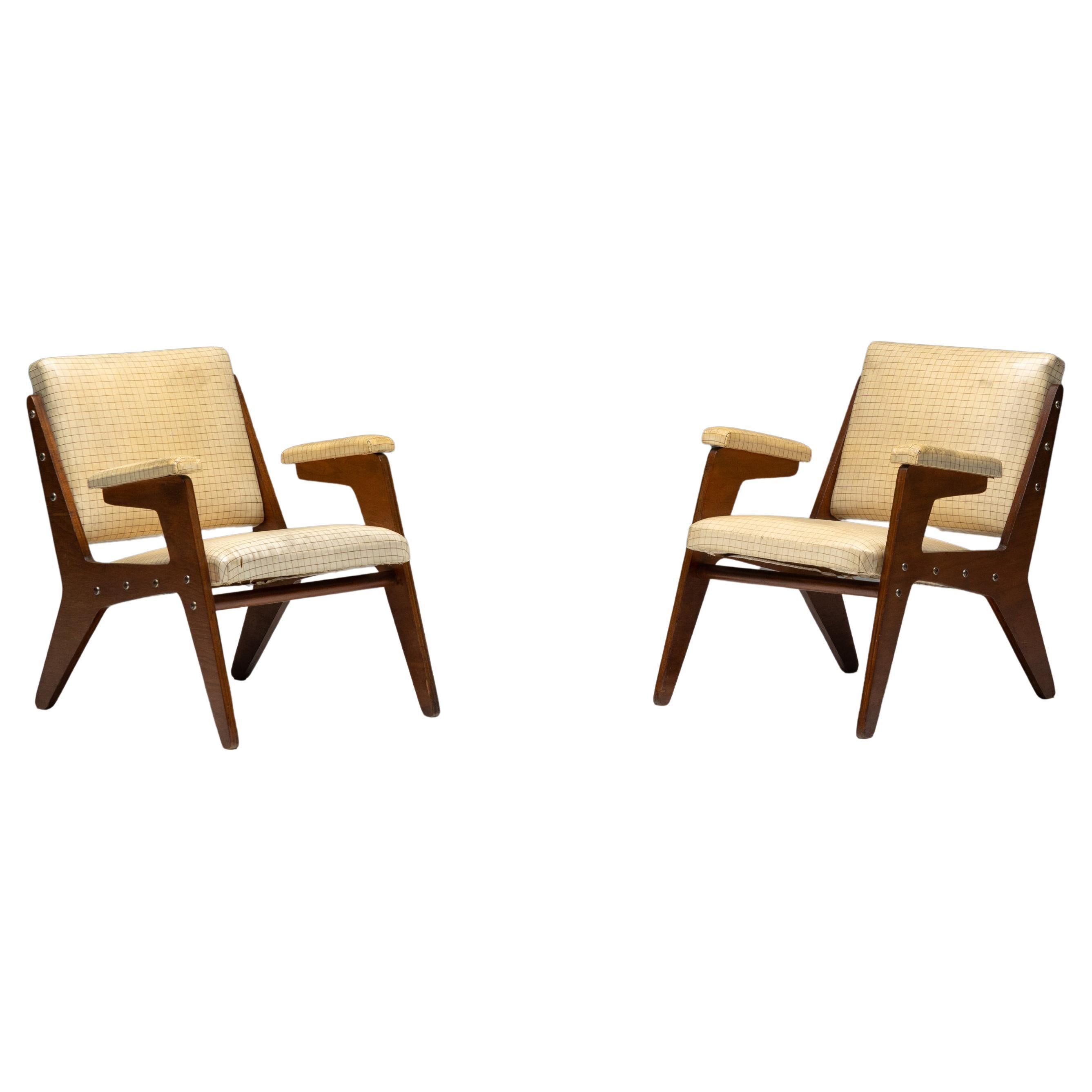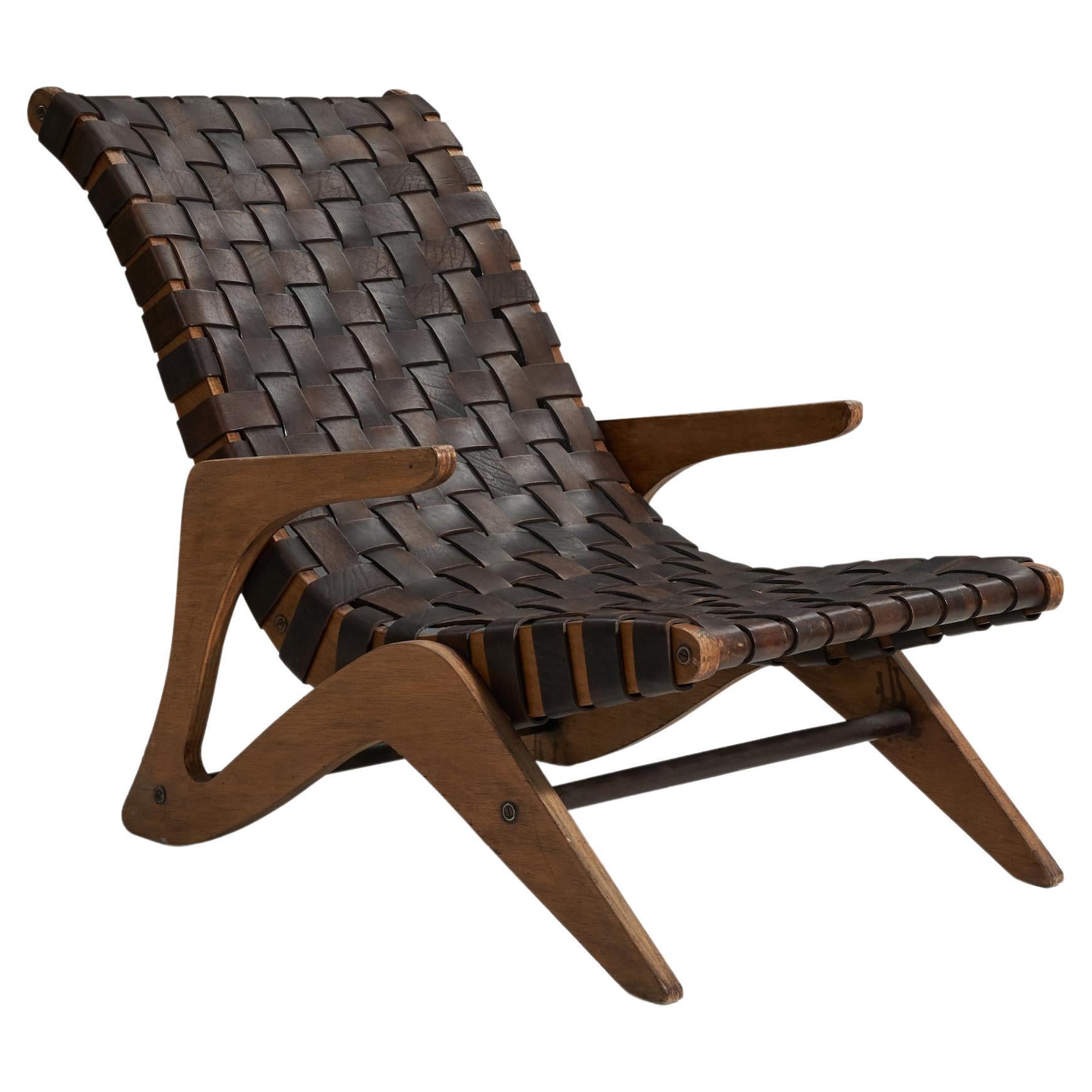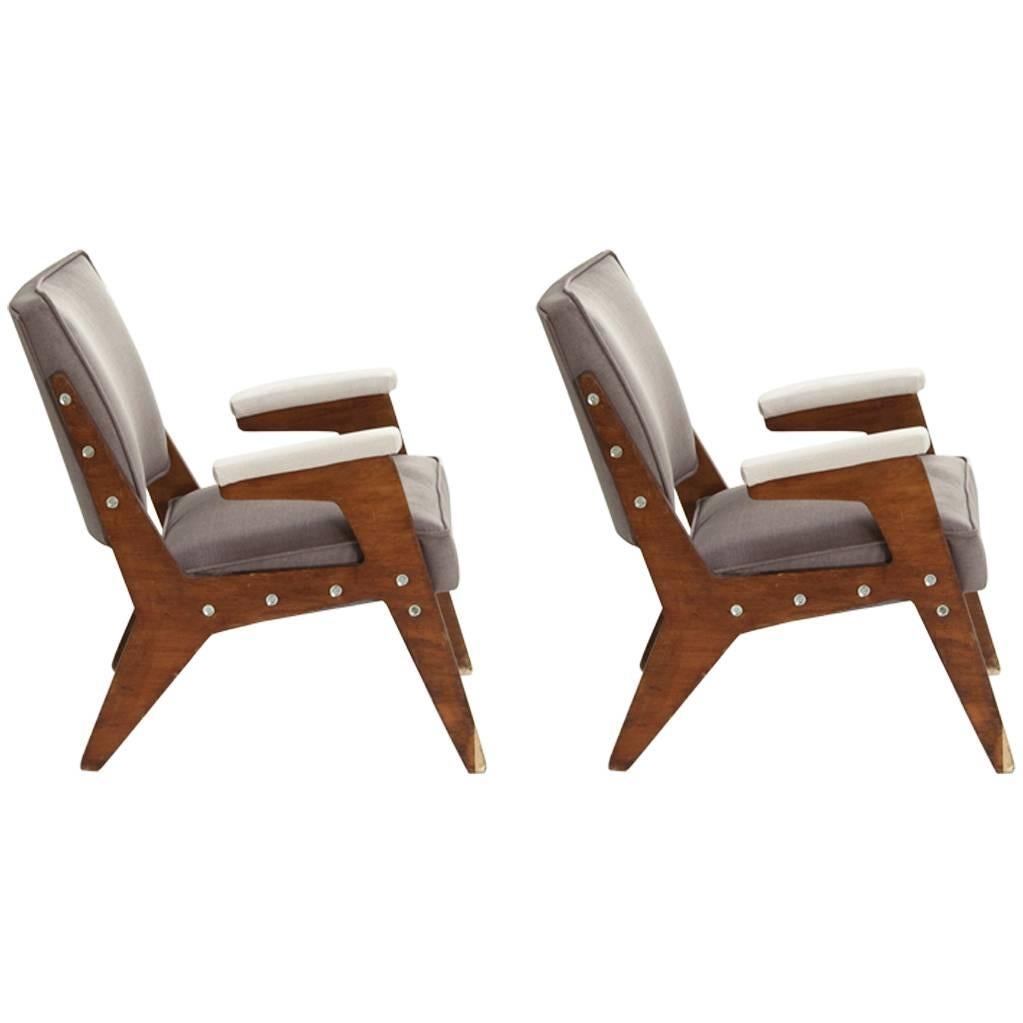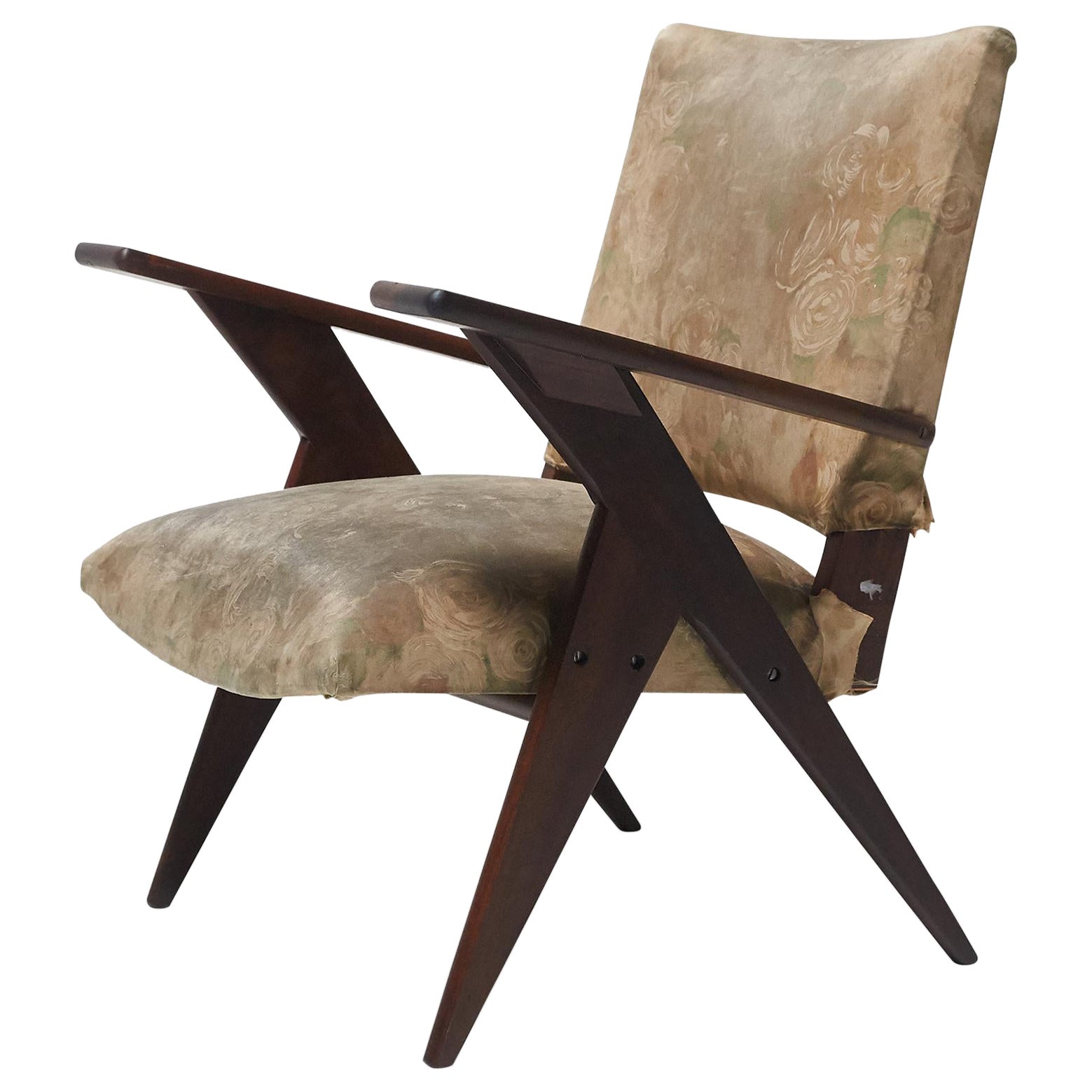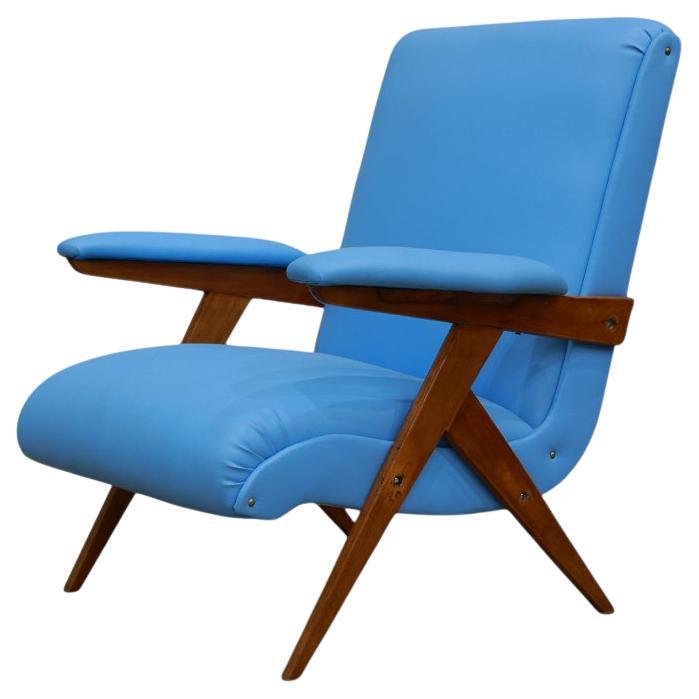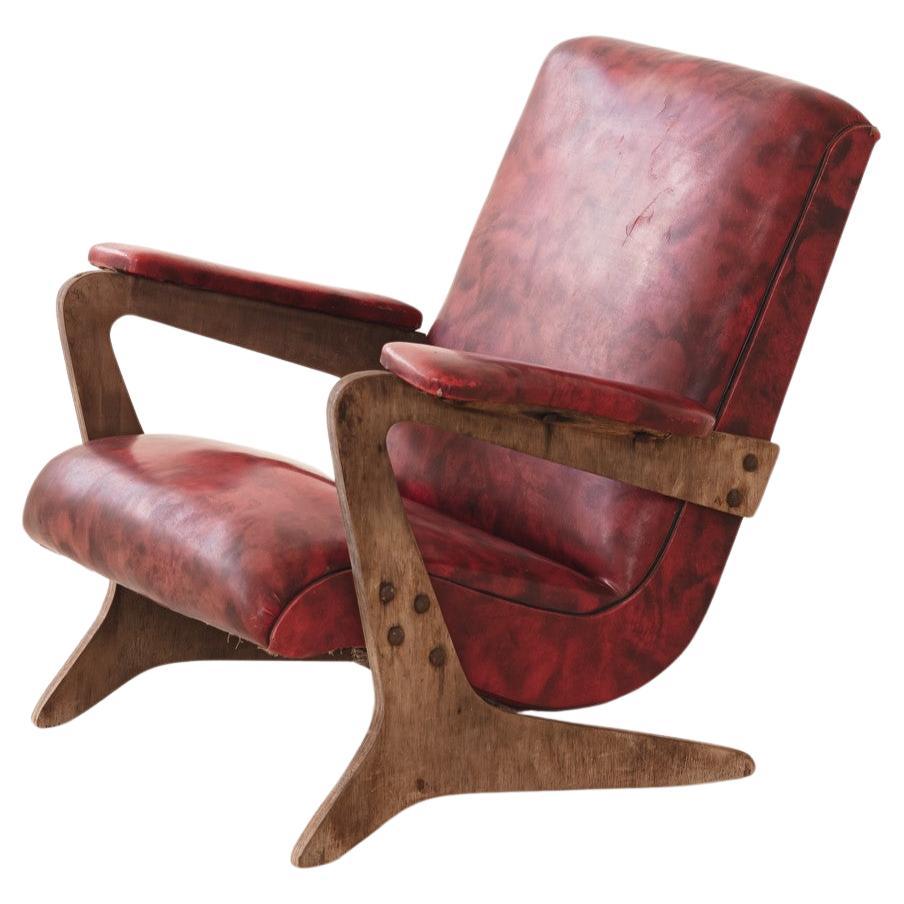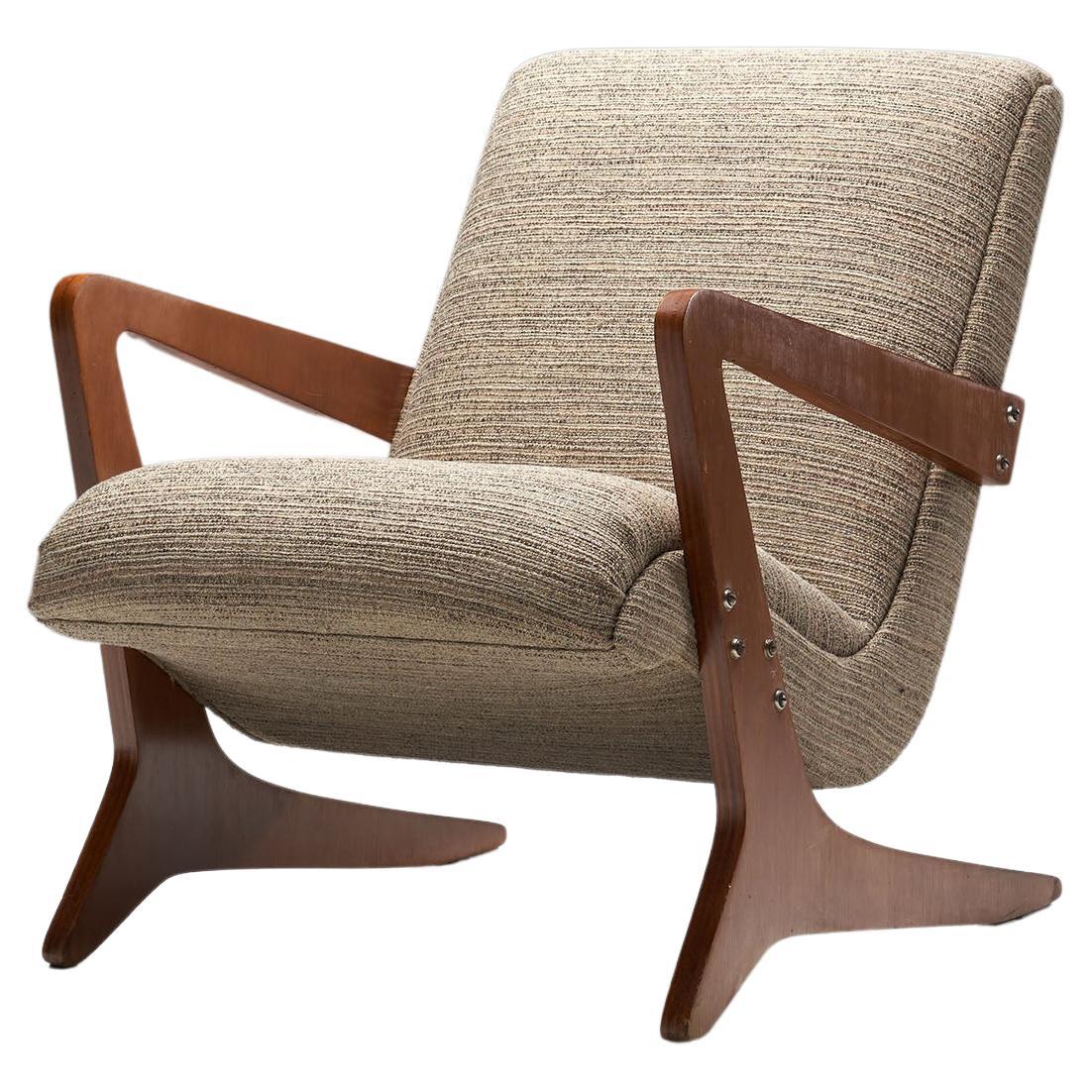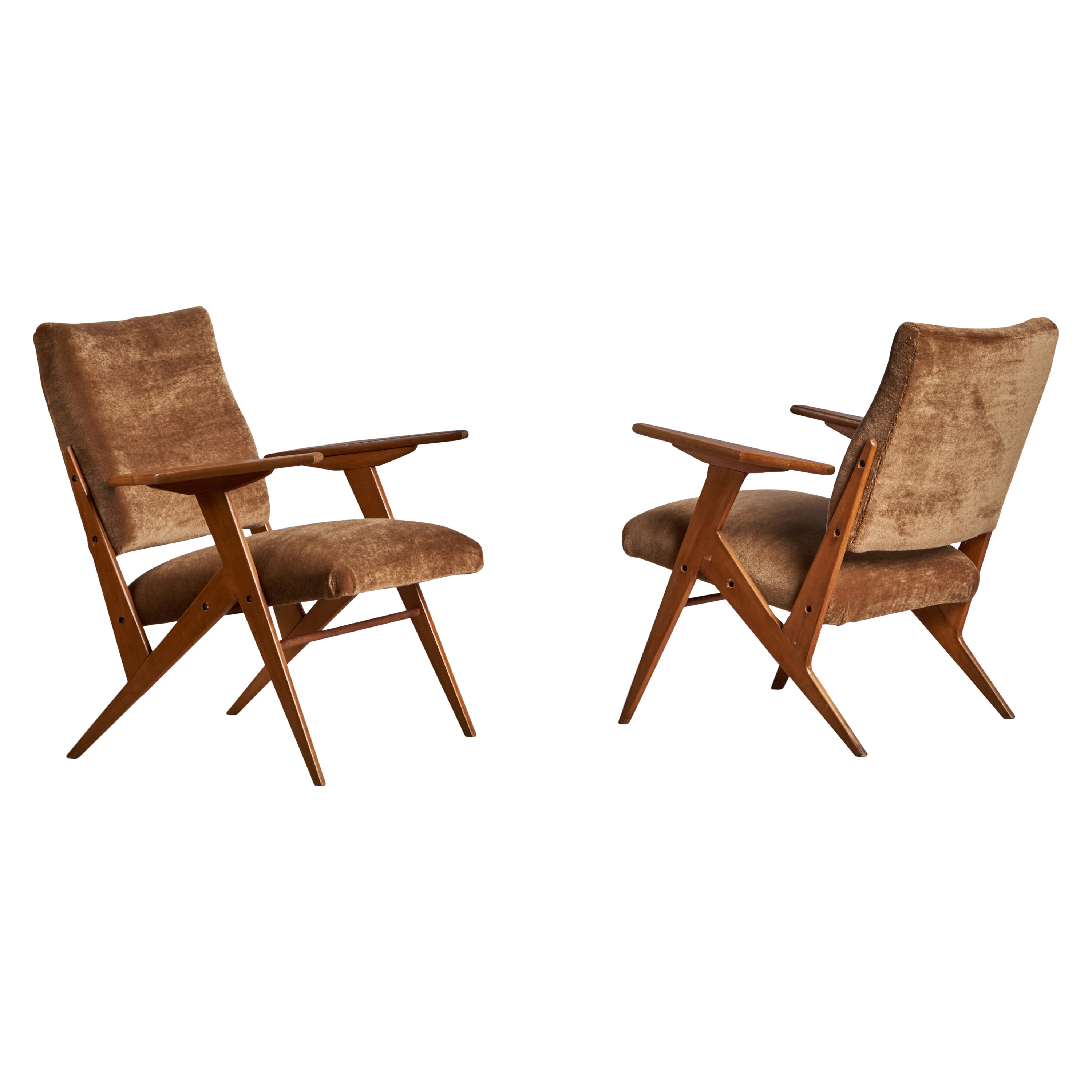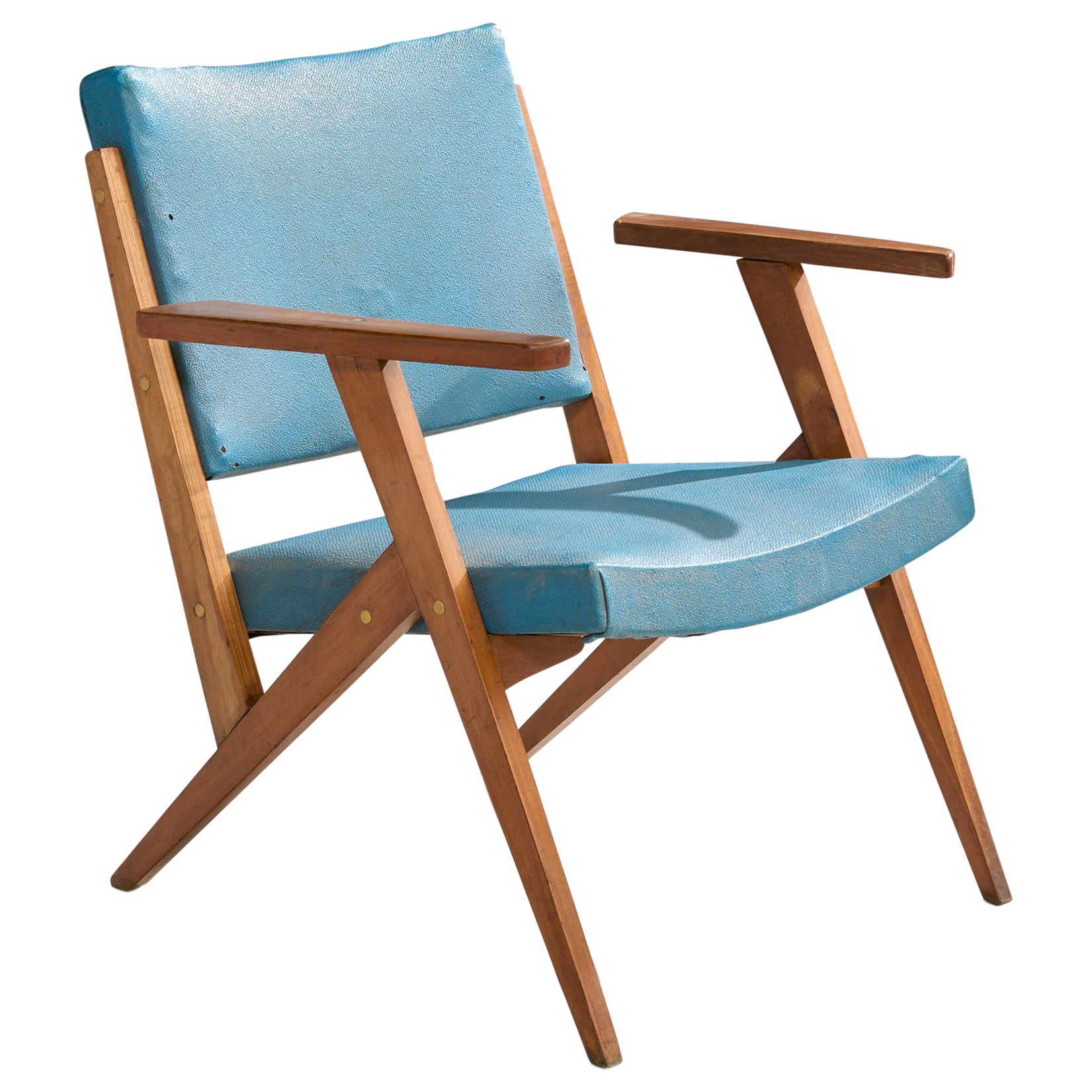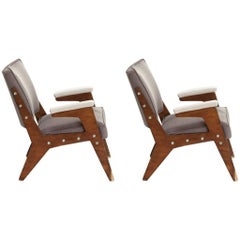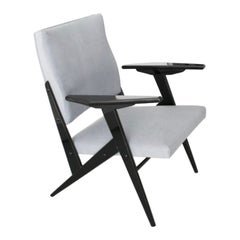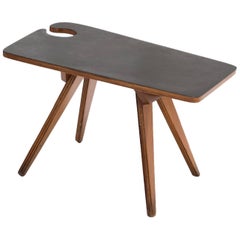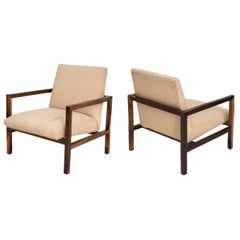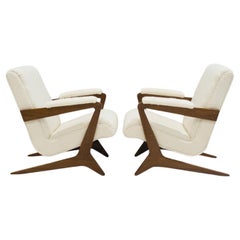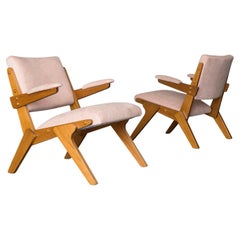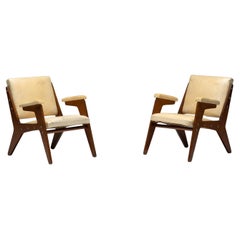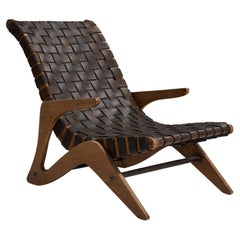
Jose Zanine Caldas Brazilian Pair of Armchairs Lacquered Wood Cream White Fabric
View Similar Items
Want more images or videos?
Request additional images or videos from the seller
1 of 7
Jose Zanine Caldas Brazilian Pair of Armchairs Lacquered Wood Cream White Fabric
About the Item
- Creator:José Zanine Caldas (Designer)
- Dimensions:Height: 30.71 in (78 cm)Width: 25.2 in (64 cm)Depth: 25.99 in (66 cm)Seat Height: 16.93 in (43 cm)
- Style:Mid-Century Modern (Of the Period)
- Materials and Techniques:
- Place of Origin:
- Period:
- Date of Manufacture:1954
- Condition:Wear consistent with age and use.
- Seller Location:Barcelona, ES
- Reference Number:1stDibs: LU2374320348462
About the Seller
5.0
Recognized Seller
These prestigious sellers are industry leaders and represent the highest echelon for item quality and design.
Established in 2015
1stDibs seller since 2016
99 sales on 1stDibs
Typical response time: 1 to 2 days
Authenticity Guarantee
In the unlikely event there’s an issue with an item’s authenticity, contact us within 1 year for a full refund. DetailsMoney-Back Guarantee
If your item is not as described, is damaged in transit, or does not arrive, contact us within 7 days for a full refund. Details24-Hour Cancellation
You have a 24-hour grace period in which to reconsider your purchase, with no questions asked.Vetted Professional Sellers
Our world-class sellers must adhere to strict standards for service and quality, maintaining the integrity of our listings.Price-Match Guarantee
If you find that a seller listed the same item for a lower price elsewhere, we’ll match it.Trusted Global Delivery
Our best-in-class carrier network provides specialized shipping options worldwide, including custom delivery.More From This Seller
View AllJose Zanine Caldas Pair of Mid-century modern BrazilianArmchairs Model "H"
By José Zanine Caldas
Located in Barcelona, ES
JOSE ZANINE DE CALDAS (1919-2001).
Pair of armchairs model “H.”
Manufactured by Moveis Artísticos Z.
Brazil, 1949.
Marine plywood, fabric upholstery.
Measuremenents
58 cm x 50 cm x 80 H cm.
Literature: Habitat, nº9, Sao Paulo 1952.
José Zanine Caldas (Belmonte, Bahia, 1918 - Vitória, Espírito Santo, 2001) was an architect and designer. Caldas stands out on the national architecture in Brazil for his exploration of the constructive qualities of Brazilian woods, defining his work with a warm rustic ambience, working on both high-end residential projects and also popular constructions.
Never actually training as an architect, he starting working in the 1940s as a designer at Severo & Villares and as a member of the National Artistic Historical Heritage Service (Sphan). He opens a maquet studio in Rio de Janeiro, where he worked between 1941 and 1948, and, at the suggestion of Oswaldo Bratke (1907-1997), moved the studio to São Paulo, from 1949 to 1955. The studio served important modern architects of the two cities, and was responsible for most of the models presented in the book Modern Architecture in Brazil, 1956, by Henrique E. Mindlin (1911-1971)..
During the 1940s, he also began developing and researching at the Institute of Technological Research of the University of São Paulo (IPT/USP), and was first introduced to plywood. In 1949, he founded the Fábrica Móveis Artísticos Z, with the objective of producing large-scale industrialized furniture, good quaility and afforable, the furniture was to be materialized using plywood sheets. This method minimized material waste and the need for artisan skills, as the parts were mechanically produced and the use of labor was only needed for the assembling of the furniture.
His time at Móveis Artísticos Z, in 1953 was rather short lived and left the company in 1953 and instead worked on landscape projects until 1958 in São Paulo, when he moved to Brasília, where he built his first house, also in 1958, and coordinated the construction of others until 1964. Appointed by Rocha Miranda to Darcy Ribeiro (1922-1997), he joined the University of Brasília (UnB) in 1962 and taught modeling classes until 1964, when he lost his position due to the military coup. He set off and travelled through Latin America and Africa, an experience that had a remarkable effect on his work.
On return to Brazil he built his second house, the first of a series of projects in the Joatinga region of Rio de Janeiro. In 1968, he moved to Nova Viçosa, Bahia, and opened a workshop, which ran up until 1980. His experience in the Bahian city was shaped by his renewed love and contact with nature, and he began working closely with environmentalists. In one of these collaborations, he participated in the project of an environmental reserve with the artist Frans Krajcberg (1921-2017) for whom he also designed a studio in 1971. The furniture he designed during this period, is reflective of his ecological sensitivity, his works were constructed with crude logs of wood, whose twisted lines inspire his drawings.
It is also in Nova Viçosa that the architect builds the Casa dos Triângulos (1970) and casa da Beira do Rio (1970), in which he adopted a very artisanal construction system with typical woods of the region. According to the historian and architecture critic Roberto Conduru, Caldas' performance was relevant for the diffusion of environmental values in architectural projects: a "taste for the alternative and the rustic was disseminated throughout the Brazilian territory [...], encouraged by environmental preservation campaigns, by the wear and tear of the current models in reinforced concrete and by the re-emergence of the regionalist ideal in the international panorama"1.
Between 1970 and 1978, he kept an office in Rio de Janeiro, where he returned in 1982. In 1975, the filmmaker Antonio Carlos da Fontoura made the film Arquitetura de Morar, about the houses of Joatinga, with a soundtrack by Tom Jobim (1927-1993), for whom Caldas designed a house. Two years later, the architect's work was exhibited at the Museum of Modern Art of Rio de Janeiro (MAM/RJ), at the São Paulo Museum of Art Assis Chateaubriand (Masp) in Belo Horizonte, and the following year at Solar do Unhão, in Salvador.
Between 1980 and 1982 The Helium House Olga Jr was designed and built in São Paulo. Caldas outlined the plans for the construction sourcing the all the wood, the actual assembly of the house was carried out by the owner. The house, is defined by wooden structure that stands out from the fence walls, the clay tile roof of wide eaves and the demolition materials that give the building the feeling of rusticity, warmth and nostalgia. The house was similar to those built in the 1970s for Eurico Ficher and Pedro Valente, in Joatinga.
In 1983, Calders founded the Center for the Development of Applications of The Woods of Brazil (DAM), and gave it to UnB in 1985. During this period, he proposed the creation of the Escola do Fazer, a teaching center focused on the use of wood for the construction of houses, furniture and utilitarian objects for the low-income population.
Despite the fact that much of Calders early work was centered around building houses for the elite, in the 1980s the designer dedicates himself the DAM where he rigorously researches popular housing based on artisan construction processes and whereby the users participate in the construction process. At the Brasília unit, he developed prototypes of popular houses with eucalyptus logs as a structure and sealing in soil-cement, betting on an ideal of self-construction already tested at Casa do Nilo, in São Gonçalo, Rio de Janeiro. From that moment on, as occurred with his the furniture designs, Caldas adopts the use of crude wood logs rolled...
Category
Mid-20th Century Brazilian Mid-Century Modern Armchairs
Materials
Plywood, Velvet
Armchair by José Zanine Caldas
By José Zanine Caldas
Located in Barcelona, ES
Pair of armchairs, 1954
Lacquered wood, fabric upholstery
66 x 64 x 78h cm 26 x 25.19 x 30.7h in
Category
Vintage 1950s Brazilian Armchairs
Materials
Wood
Jose Zanine Caldas Mid-century modern Brazilian Side Table marine plywood 1950
By José Zanine Caldas
Located in Barcelona, ES
Jose Zanine de Caldas (1919-2001).
Side table.
Manufactured by Mòveis Artísticos Z,
Brazil, 1950.
Marine plywood.
Measuremenents:
70 cm x 46...
Category
Mid-20th Century Brazilian Mid-Century Modern Side Tables
Materials
Plywood
Branco e Preto Pair of Modern Brazilian Armchairs solid jacaranda wood, fabric
By Branco & Preto
Located in Barcelona, ES
Branco e Preto (Miguel Forte, Jacob Ruchti, Plinio Groce, Roberta Aflalo, Carlos Millan & Che Y Hwa)
Pair of armchairs model “R3”
Sold as individual it...
Category
Mid-20th Century Brazilian Mid-Century Modern Armchairs
Materials
Upholstery, Jacaranda
Martin Eisler & Carlo Hauner Modern Brazilian Pair of Low Armchairs White Fabric
By Carlo Hauner and Martin Eisler, Forma Brazil
Located in Barcelona, ES
Martin Eisler (1913-1977) & Carlo Hauner (1927-1997)
Pair of low armchairs
Manufactured by Forma Moveis
Brazil, 1950s
Black painted metal, fabric upholstery.
Measurements
70 cm x 53 cm x 71 H cm.
27.5 in x 21 in x 28 H in.
Literature
Brazil Modern, the rediscovery of 20th century Brazilian furniture – Aric Chen, 2016.
Martin Eisler (Vienna, Austria, 1913 - São Paulo, Brazil, 1977), was an architect and furniture designer. He was part of a group of European architects and designers who left Europe during the chaos of the Second World War and went to live and work in Brazil. Eisler stood out amongst this group of creatives, his work was at the forefront of modern furniture design in Brazil which flourished through the 50s and 60s in the region. The work of Martin Eisler in partnership with Carlo Hauner (1927-1996) was of particular significance.
Eisler left Europe in 1938 due to the rise of fascist regimes. He first lived in Argentina, where he was settled and worked as an architect, set designer and interior designer, he opened up an interior design firm Interieur Forma. In 1940, he married Rosl Wolf, the daughter of German immigrants.
Born in Brescia in 1927, Carlo Hauner studied technical drawing and drawing at the Brera Academy in Milan, Italy. In 1948 he successfully participated in the Venice Biennale after which he moved to Brazil, where he dedicated himself to the design of textile, ceramics, furniture and architecture. In only a very short time he founded a furniture production company and purchased a factory from Lina Bo Bardi and her husband Pietro Bardi, renaming it Móveis Artesanal.
In 1953 Hauner met Martin Eisler, who was looking for help to produce furniture for the home of his brother-in-law, Ernesto Wolf. Eisler reached out to Hauner and the rest is history. The two men connected and with Wolf’s financial backing, they opened Galeria Artesanal (a store for their company Móveis Artesenal) on a busy street in São Paulo.
Being highly ambitious and with an eye on the international market as well as the upcoming office market, Móvies Artesanal later changed into Forma. Along with Oca, Forma became one of the biggest names in Brazilian furniture production. Even managing to attract an exclusive license to sell Knoll furniture, bringing big names in international design such as Mies Van Der Rohe, Charles Eames and Harry Bertoia to the Brazilian furniture market. Hauner and Eisler’s designs are characterized by the use of Brazilian woods, thin tubular frames and a range from furniture, to ceramics and textiles. Some of their most famous designs are the “rib” lounge chair...
Category
Mid-20th Century Brazilian Mid-Century Modern Armchairs
Materials
Metal
Liceu De Artes e Oficios Pair of Midcentury Brazilian Jacaranda Armchairs Cream
By Liceu de Artes e Ofícios
Located in Barcelona, ES
Liceu de artes e oficios
Pair of armchairs
Manufactured by Liceo de Arte e Oficios
Brazil, 1950
Solid jacaranda and upholstery
Cream upholstered Mid-Century Modern
Measure...
Category
20th Century Brazilian Modern Armchairs
Materials
Upholstery, Jacaranda
You May Also Like
Pair of José Zanine Caldas Zeca Armchairs
By José Zanine Caldas, Mòveis Artisticos Z
Located in Madrid, ES
The "Zeca" chair was created in the early 1960s by a Brazilian designer José Zanine Caldas (1918-2001) for Móveis Artísticos Z, a factory he founded in São José dos Campos in 1948. T...
Category
Mid-20th Century Brazilian Mid-Century Modern Armchairs
Materials
Bouclé, Hardwood, Plywood
$43,991 / set
José Zanine Caldas Armchairs, Pair, 1950s, Brazil
By José Zanine Caldas
Located in Edogawa-ku Tokyo, JP
A pair of beautiful armchairs designed by José Zanine Caldas from Brazil.
Reupholstered with light pink colored fabric.
Very good vintage condition.
Category
Vintage 1950s Brazilian Mid-Century Modern Armchairs
Materials
Upholstery, Wood
$23,000 / set
'H' Armchairs by José Zanine Caldas, Brazil, 1950s
By José Zanine Caldas
Located in Antwerp, BE
This set of two lightweight armchairs by José Zanine Caldas exemplifies his mastery of form and material. Constructed with two precision-cut plywood pieces screwed to the seat and ba...
Category
Vintage 1950s Brazilian Mid-Century Modern Armchairs
Materials
Fabric, Plastic, Plywood
José Zanine Caldas, Lounge Chair, Imbuia Plywood, Leather, Brazil, 1950s
By Mòveis Artisticos Z, José Zanine Caldas
Located in High Point, NC
A lounge chair designed by José Zanine Caldas for Mòveis Artísticos Z, Brazil, in 1949. It features Imbuia plywood, brass, and black-dyed leather webbing.
Category
Vintage 1940s Brazilian Mid-Century Modern Lounge Chairs
Materials
Leather, Imbuia
Jose Zanine Caldas Armchair
By José Zanine Caldas
Located in San Francisco, CA
A Brazilian hardwood armchair by José Zanine Caldas with paddle arms and his signature angular lines.
The wood has been refinished and is in excellent condition. The upholstery is i...
Category
Vintage 1960s Brazilian Modern Armchairs
Materials
Upholstery, Hardwood
Brazilian Modern Armchair in Wood & Leatherette, Jose Zanine Caldas, 1950s
By José Zanine Caldas
Located in New York, NY
Available right now, this Brazilian Modern armchair in wood & faux leather by Jose Zanine Caldas, in the fifties decade is gorgeous!
The Z armchair, crafted from solid ivory wood or...
Category
Mid-20th Century Brazilian Mid-Century Modern Armchairs
Materials
Faux Leather, Hardwood
$6,000 Sale Price
25% Off
